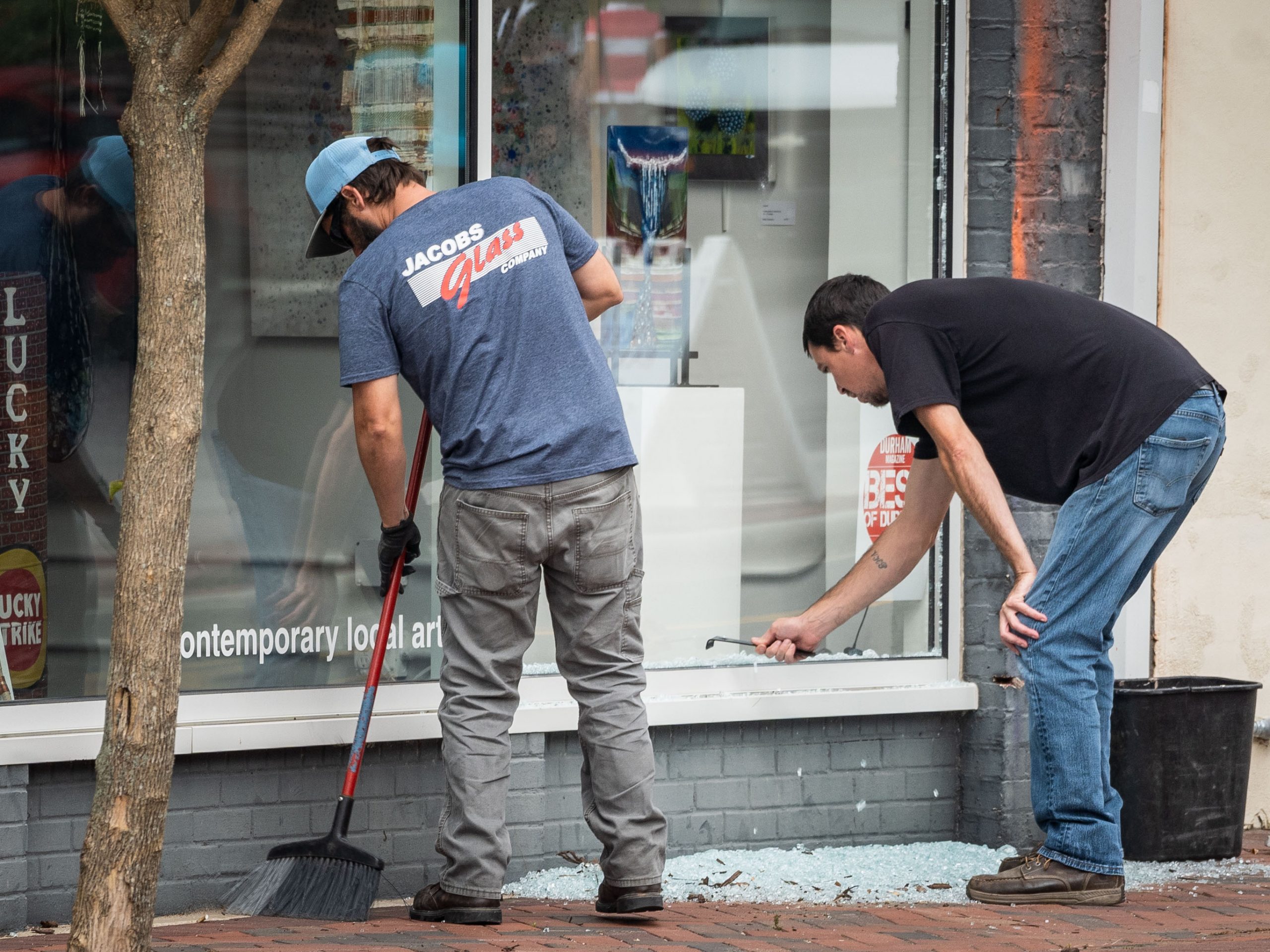By Cameron Oglesby
and Henry Haggart
After Durham’s most violent night in months of protests, Mayor Steve Schewel blamed unidentified outsiders for busting windows, spray-painting graffiti and hijacking “righteous” dissent.
“The people who inflicted this damage last night are not advancing the cause of justice,” Schewel said Thursday during a press conference. “What they’re doing is co-opting this movement for racial justice for their own purposes.”
Street protesters Wednesday damaged at least 13 buildings, both public and private, and left a church with repairs that will cost tens of thousands, the mayor said.
Because the police department had no warning of what was coming, they were unable to arrive in time to stop the vandalism, Durham Police Chief Cerelyn Davis said.
For months, police have steered clear of confronting peaceful protesters calling for fundamental changes to policing locally and nationally. That’s because the department supports their free speech, Davis said.
From now on, officers will be more visible, she vowed.
“That is the strategy that we feel that we have to take at this point, not in an antagonistic way, but in a manner that our community members know that we are there and we’re paying attention,” she said.
Neither Schewel or Davis offered any specifics on the identities of the people they accused. Most in the crowd participated in the vandalism, Davis said.
“The folks that were just inflicting the damage last night were white, I just want to be really clear about that,” the mayor said. “This is an attempt to co-opt a racial justice movement.”

On Wednesday night, an estimated 75 or more people gathered at CCB Plaza downtown for a protest advertised to express outrage over a Kentucky grand jury indicting only one of the three police officers involved in the killing of Breonna Taylor in her home on March 13.
Chanting “No Justice, No Peace” and “Defund the Police,” the group of mostly white men and women marched through the center of downtown Durham, making stops at the police department headquarters and the Durham County Justice Center.
As the march progressed, protesters at the back of the group threw trash cans, scooters, traffic cones and other objects they found on the streets into roadways to block police patrol cars following them. Officers exited their vehicles to clear the obstacles but kept their distance.
Occasionally, small groups of protesters would run to a sidewalk, umbrellas raised to conceal their faces, and spray paint messages like “say her name” and “burn it down” on the sides of buildings.
Protesters with umbrellas also harassed members of the press trying to photograph or film them, including following and briefly surrounding a 9th Street journalist.
The Rev. Paul Scott, founder of the Black Messiah Movement in Durham and a Black nationalist, was downtown Wednesday to observe the protest.
“They got a Black Lives Matter rally going on. As usual — no Black people. See they got a civil war going on. And they’re doing these things in our name, in the name of Black Lives Matter. But no Black people!,” he said during a video he made Wednesday night and posted on Facebook.
When asked Thursday if the city police could have handled Wednesday night any better, Scott said this: “I think if they were Black teenagers, they would have been dealt with a lot more harshly. I think there’s a double standard. And I think it’s a classic example of white privilege.”
He noted how police officers approached three youngsters with guns drawn at a city apartment complex last month while looking for an armed suspect. A 15-year-old, the oldest in the group playing outdoors, was handcuffed. Wednesday night was “white anarchists getting a police escort,” Scott said.
The assault on property downtown by a majority white crowd comes just as many restaurants and other businesses are beckoning paying patrons to return after six months of bleak disruption from the coronavirus pandemic.
Just last week, Downtown Durham Inc. launched The Streetery, a project to transform downtown into a socially distanced and entertaining eating experience, equipped with lights and performances on Friday and Saturday nights.
A front window of Viceroy, an Indian restaurant and British pub on West Main Street, was damaged Wednesday night, said co-owner Smita Patel. The restaurant’s landlord asked them to put up plywood, but she and her team do not feel unsafe.
“Overall, I think we still feel safe, we always have, and Durham is doing a good job of keeping people together,” Patel said. “It does affect our business, of course, the boards being up, but we’re hoping that we won’t regress back to how it was a couple months ago.”
Thursday’s press conference was a short, solemn event, with Chief Davis saying she didn’t view violence during Wednesday’s protest as a response to what many consider inadequate action against officers involved in the shooting death of Breonna Taylor. Instead, it was people “taking advantage of an opportunity to express other ideology.”
Police are investigating whether they can identify those who did the damage, a group that, she said, dispersed quickly.
“We are still looking at the video footage,” Davis said, to identify who they can.
9th Street reporters Rebecca Schneid and Charlie Zong contributed to this report.
9th Street journalists Cameron Oglesby and Henry Haggart can be reached at cameron.oglesby@duke.edu and henry.haggart@duke.edu
At top: Two men clean up broken glass Thursday outside 5 Points Gallery on East Chapel Hill Street. Photo by Henry Haggart



